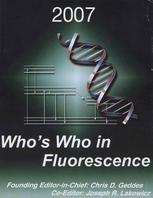

Most ebook files are in PDF format, so you can easily read them using various software such as Foxit Reader or directly on the Google Chrome browser.
Some ebook files are released by publishers in other formats such as .awz, .mobi, .epub, .fb2, etc. You may need to install specific software to read these formats on mobile/PC, such as Calibre.
Please read the tutorial at this link: https://ebookbell.com/faq
We offer FREE conversion to the popular formats you request; however, this may take some time. Therefore, right after payment, please email us, and we will try to provide the service as quickly as possible.
For some exceptional file formats or broken links (if any), please refrain from opening any disputes. Instead, email us first, and we will try to assist within a maximum of 6 hours.
EbookBell Team

5.0
38 reviewsAbout the Editors
Chris D. Geddes, Ph. D.,
Dr. Chris D. Geddes Ph.D., Professor, is Director of the Institute of Fluorescence and Associate Director of Center for Fluorescence Spectroscopy at the University of Maryland Biotechnology Institute, Medical Biotechnology Center in Baltimore, USA. He has a B.Sc. from Lancaster University in England and a Kodak funded Ph.D. in Physical Chemistry (fluorescence spectroscopy) from the University of Wales Swansea, UK. Dr Geddes is the Editor-in-Chief of the Journal of Fluorescence, and both the Editor and Founding editor-in-chief of the Who’s Who in Fluorescence, Annual Reviews in Fluorescence, Annual Reviews in Plasmonics volumes and of "Plasmonics", Springer's latest Peer reviewed journal. He is also Executive Director of the Society of Fluorescence and co-editor of the popular series Topics in Fluorescence Spectroscopy. Dr Geddes has published approximately 150 articles and 13 books / volumes on the principles and applications of Fluorescence Spectroscopy and Plasmonics. The Institute of Fluorescence features two main laboratories, which underpin Dr. Geddes’s research aspirations, namely; The Laboratory of Advanced Medical Plasmonics and the Laboratory for Advanced Fluorescence Spectroscopy. Both laboratories are poised to advanced our knowledge of fluorescence / plasmonics and their applications. Current research is based on developing a fundamental understanding of metal-enhanced fluorescence (also termed radiative decay engineering and surface-enhanced fluorescence), with outcomes focused at developing a unified plasmon-fluorophore theory for downstream biomedical applications. Other research involves developing microwave based plasmonic devices for ultra fast and ultra sensitive sensing platforms.
Joseph R. Lakowicz, Ph. D.,
Dr. Joseph R. Lakowicz Ph.D., Professor, is Director of the Center for Fluorescence Spectroscopy at the University of Maryland School of Medicine in Baltimore. He has a BS in chemistry from LaSalle University and an MS and Ph.D. in Biochemistry from the University of Illinois at Urbana. He is the founding editor of the Journal of Biomedical Optics and the Journal of Fluorescence. He is also co-founder and co-President of the Society of Fluorescence. In addition he is also co-editor of the Who’s Who in Fluorescence, Annual Reviews in Fluorescence and Topics in Fluorescence Spectroscopy volumes. Dr. Lakowicz’s research is focused on advancing the field of fluorescence spectroscopy. This involves chemical synthesis of new fluorophores, development of novel fluorescence measurements, development of instrumentation for time-resolved fluorescence, and the chemical applications of fluorescence sensing. More recently he has been investigating the effects of metallic surfaces on modifying the free-space fluorescence spectral properties of near-by fluorophores, with potential applications spanning the analytical and biomedical sciences. In this regard Dr. Lakowicz has recently developed a new technology, Surface Plasmon Coupled Emission, which promises to significantly enhance the detectability of species of interest, in close proximity to metallic surfaces, with regard to angular emission, wavelength discrimination, polarization and proximity.